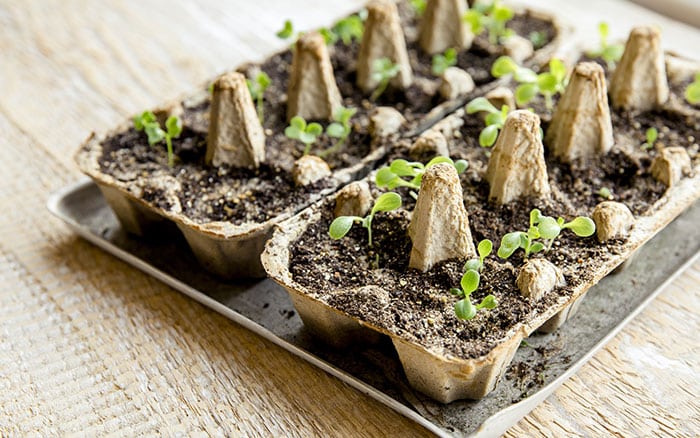Think not having a large garden or allotment should stop you growing? Think again.
Even the smallest patio or balcony can be turned into a plant paradise using pots, containers and planters. And, if you’re on a budget or really strapped for space, all sorts of weird and wonderful objects can be turned into planting pots.
Here are some inventive ways to get growing that show you can make a planter out of almost anything.
Pots a-plenty
Not everyone has a garden but you really can grow plants in anything that has the capacity to hold soil. Dustbins are great for growing potatoes if you’re short on space.
Pick up an inexpensive plastic bin, drill a few drainage holes in the bottom, fill with compost or soil and then sow your seed potatoes on top.
As kids grow out of Wellington boots so quickly, why not reuse old pairs?

Put some holes in the sole of the boots and screw them on to fence panels or outside walls to create an array of interesting wall containers.
Chipped coffee cups, empty egg boxes and even plastic biscuit tins can be recycled into containers to help seeds germinate or grow cuttings on your kitchen windowsill.
Used plastic bottles also have a variety of uses – cut the bottoms off and use them as mini-propagators over the tops of peas to protect them from late frosts, pigeons and other predators. And old milk cartons with the tops lopped off make great soil scoops or window planters.
Bags of space

Grow bags are great for vegetables and work a treat on patios and balconies. They’re normally used for tomatoes but I’ve seen them packed with salad leaves, flowers and herbs.
There’s no need for anything else – just open them up as directed, place your plants or vegetables into them, and get growing. The secret is to make sure you’ve got enough space.
Some people cut the whole top section of the plastic off, peel it back and then plant straight into the soil. But I prefer to cut squares out where I plan to plant. This helps stop weeds growing and prevents bags from drying out in the sun – just make sure the soil is moist.
The average grow bag can grow three plants quite comfortably. Keep them in the bags for about a year then plant them out. I like Levington’s Gro-Bag, and the Miracle-Gro® Performance Organics Fruit & Veg Planter.
The secret with anything grown in a container – whether it’s a a wellie, traditional pot or grow bag – is to feed on a regular basis with something like Miracle-Gro® All Purpose Concentrated Liquid Plant Food. Simply mix your formula into a watering can and off you go.
Trowel to table
It’s easy to create a productive herb garden with thyme ready to harvest for chicken dishes, parsley for soups, and sage for scrumptious stuffing. Chives make an excellent addition to any omelette, while there’s basil for pasta, and oregano for delicious pizza toppings.
To plant, simply dig a hole, loosen the plant by giving the pot a squeeze with your fingers and pop it in a grow bag or container.

Position it so that the soil remains at the same level as it was in the pot and water the plants in well. Give them a bit more while they’re new, but don’t waterlog the container. Trim the herbs so they continually produce – basil, oregano and parsley can get a bit leggy if they aren’t cropped regularly.
Chillies and peppers grow really well in grow bags and containers, too. Planting two in a bag produces really big plants.
Alternatively, create a flowering grow bag by cutting a big triangle out of the centre and planting some geraniums, marigolds and begonias.
Tip:
Use ordinary household vinegar mixed
with hot water to clean paving slabs. They’ll come
up looking fabulous and it won’t harm
people or pets.
This is a particularly good idea for children as it will teach them patience, how to nurture plants and connect with nature.
Happy gardening everyone!
Reader questions
I have moss all over my front lawn. How can I get rid of it?

Apply a moss treatment, wait for a week, then rake it over. The moss should easily come away. Aerate the ground and add topsoil, if needed, then re-seed with a grass variety that’s best suited for your soil type. The best non-chemical solution is scarification with a spring-tine rake.
I want to plant some easy veggies. Any suggestions?

Try sowing some beetroot. It should be ready to harvest in around seven to 12 weeks. Spinach is another thing you can grow now for a summer harvest, and lettuce and cucumber, too. There’s still time to get some carrots into the ground for autumn harvesting, too.

could you please let me know were I can purchase the recycled planter seen on Monday show thankyou
Hi Janet,
The recycled raised beds are from a company called Garland, here’s a link to the their website:
https://www.garlandproducts.com/grow-bed.html